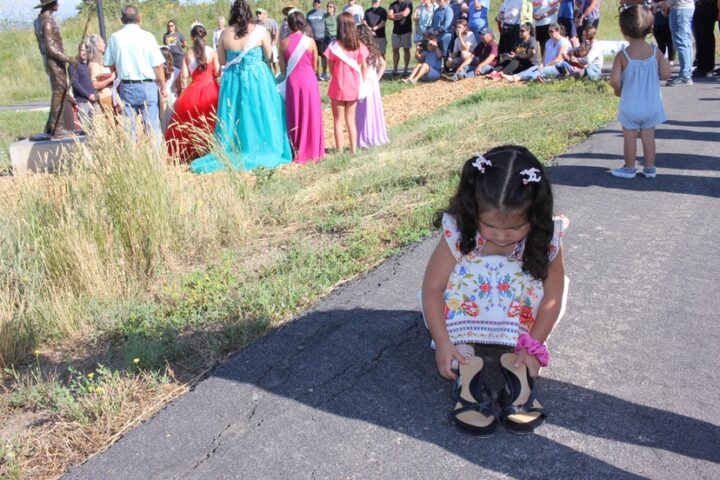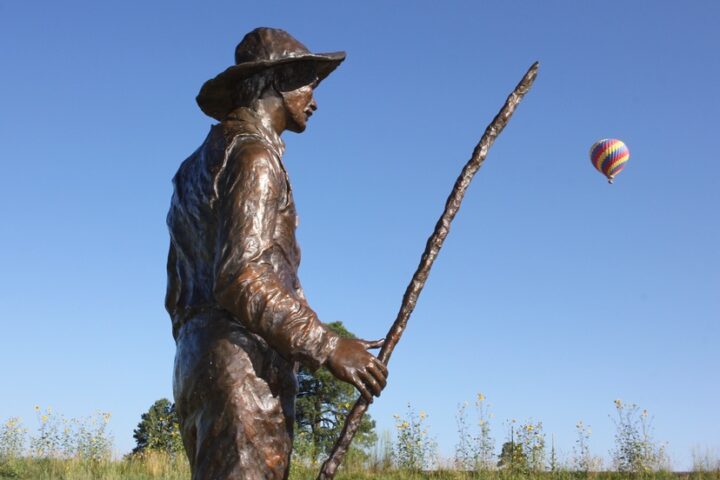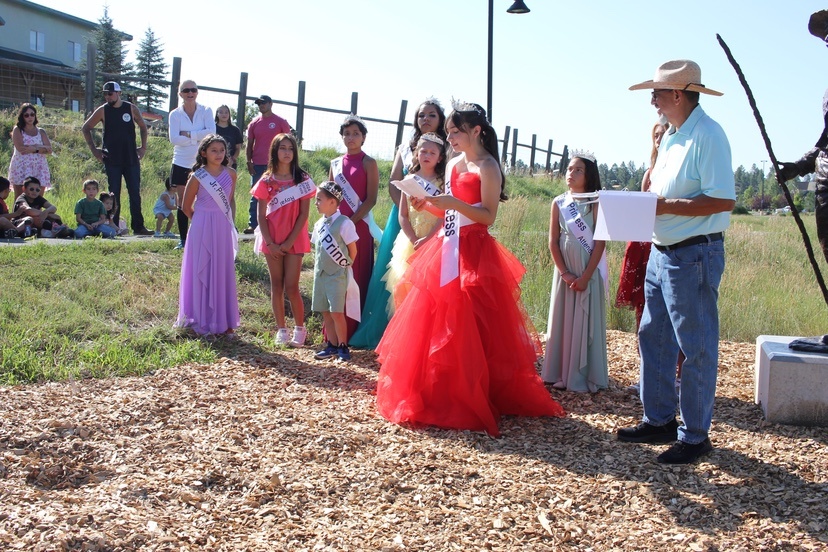PHOTO: Lillyan Vega shares a story about sheepherders, from her family’s history, at the sculpture dedication on Saturday, July 27, as the Spanish Fiesta Royalty and Town Council member Leonard Martinez listen.
Several speeches were made at the Saturday dedication of Chad Haspels new bronze sculpture, “Weminuche Meadows”, including a story shared by one of the Spanish Fiesta Royalty, Lillyan Vega.
The sculpture, now installed beside the walking path in Aspen Village, represents a sheepherder, with staff in hand, gazing off towards the northeast. He could, in fact, be thinking about an historical incident that took place in that general direction. The incident illustrated the ill-will that sometimes existed between Archuleta County’s typically-Anglo cattle ranchers and the community’s typically-Hispano sheepherders.
Ms. Vega:
“This story takes place on the last day of April, 1892, at the foot of Wolf Creek Pass…
“…Back then, cattlemen did not like sheep men. They would kill their sheep, and poison their sheep.
“Juan Montoya and other sheepherders were bring a huge amount of sheep over Wolf Creek Pass and down the San Juan River with permission from land owners. Some say they were coming from Del Norte; others say they were going to Del Norte.
“William Howe, his brother Abe and their friend Joe Mann were in the living room of William’s house that looked over the San Juan River. Joe Mann was looking out the window when he saw the sheepherders along the San Juan River, herding about 20,000 sheep. Can you imagine 20,000 sheep? I can’t.
“Joe Mann told William Howe and his brother Abe about the sheepmen, and they saddled up and made their way down to the sheepherders and stopped. They were armed with rifles.
“Juan Montoya was on lookout while the other sheepherders were minding the flock. He saw three armed men on horses, riding towards him. Shots were fired, and Juan was shot in the shoulder.
“Juan Montoya shot back in self-defense. At the end of the shooting, William Howe was dead. He died because of his wounds. Juan Montoya was badly hurt…
“Sheriff Billy Kern was notified about the shooting. About this time, Juan Montoya’s father, Luis Montoya, was notified about the shooting as well. Later, Sheriff Kern arrested Juan Montoya and charged him with murder. For Juan Montoya’s safety, he was kept in Ma Cade’s Hotel. The next day, Sheriff Billy Kern took Juan to Durango where he was held for trial. Luis Montoya was a man of means and hired the best attorney in the state of Colorado to defend his son.
“Juan Montoya was found innocent of the charges, as the jury found him to have acted in self-defense…”
Ms. Vega concluded by noting that Luis and Juan Montoya were her relatives.
“I hope you have enjoyed my story. Thank you for listening.” The audience rewarded her with a round of applause.
I found other versions of this same story in the Pagosa Springs SUN, as told by local historian John Motter. You can read parts of them here, and here. and here.
Mr. Motter notes that “down through history, the Howe ranch located at the foot of Wolf Creek Pass has become known as the At Last Ranch.”
Years later, old-timers in Pagosa referred to the shootout as the “Montoya-Howe Sheepmen’s-Cattlemen’s War”.
Here are a few additional details shared by Mr. Motter.
Apparently, Sheriff Kern had lost his trigger finger to a frostbite injury, but had developed a technique for ‘fanning’ the hammer of his Colt .45 to defend himself. To facilitate this technique, he had removed the trigger from his revolver.
His gun-handling reputation may have come in handy when he decided to house his prisoner, Juan Montoya, at Ma Cabe’s Hotel instead of at the county jail.
Once back in Pagosa Springs, Kern bedded his prisoner down at Ma Cade’s hotel. He was convinced it was a better place than the flimsy county jail to defend his prisoner from the angry lynch mob gathering outside. The sheriff downed a bowl of Ma Cade’s frijoles, with a hearty “Thank you, ma’am,” but never unbuckled his trigger-less gun or took his eyes off the window, as all through the night a growing band of Montoya’s family and friends gathered on Roubideaux Hill (now Reservoir Hill) above the hotel; ready to shoot it out with the lynch mob if necessary…
I think about the difficult times in Pagosa’s history — back in the late 1800s and the first half of the 20th century — and I have to conclude that the sheep, and the cattle, were themselves essentially unrelated to the tensions. They were innocent bystanders in a cultural war. Language differences. Religious differences. Different family patterns. Economic differences.
It’s so easy to focus all our attention on differences, and ignore the shared values.
As we celebrated Chad Haspels’ bronze sculpture of the lonely sheepherder on July 27 with speeches by several people involved in the project… and as we listened to the blessing by the Catholic priest, Father Samuel Auta… and the history of the Hispano borregeros from Spanish Fiesta Committee member Leonard Martinez,… I sensed no feelings of “division” among the people in the audience or among the project participants. Everyone had come together to celebrate an aspect of Pagosa’s past embodied in a beautiful work of art, and thereby to reaffirm traditions and cultural values that continue to guide our community in 2024.

As we drive by Pagosa Peak Open School and Walmart on Highway 160, we can see the lonely sheepherder standing near the multi-use trail, and think about what that lifestyle must have been like — living high in the foothills of the San Juan mountains, perhaps alone with a few dogs and 1,000 sheep. Knowing that you and your extended family would eventually benefit economically from the wool, the mutton, and the lamb chops at the end of the season.
When I stopped by on Sunday morning, to snap a few more photos, I noticed a hot air balloon in the distance.
The balloon represents the tourist economy our community leaders have been chasing for the past 30 years. It doesn’t produce any useful products such as wool, or mutton. It produces only dollars.

Certainly, the dollars can be exchanged for wool clothing, and we always can find lamb chops at our local grocery stores.
But have we become less lonely? I wonder.

